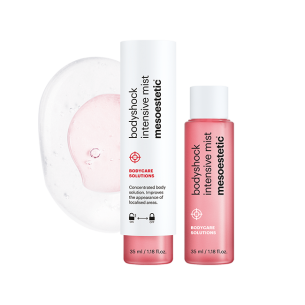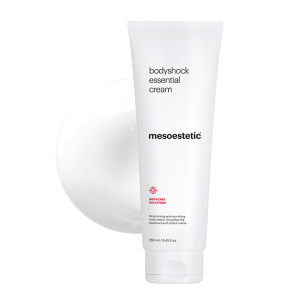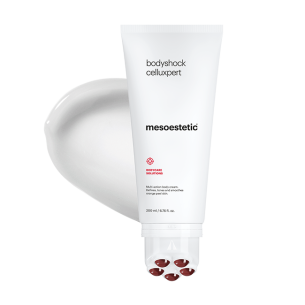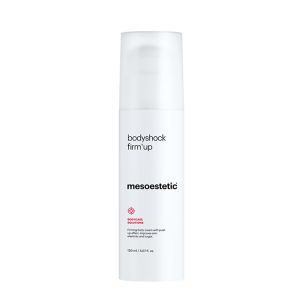Cellulite is one of the most common skin disorders among women, affecting over 80% of the female population. What is not so well known is that, although it is almost impossible to completely get rid of cellulite, treatments and effective products for reducing it do exist.

What is cellulite?
Gynoid lipodistrophy, popularly known as cellulite, is a skin disorder in which the adipocytes, or fat deposits, become highly visible when pushing against the connective tissue. In other words, when fat cells increase and push to rise to superficial layers, the connective fibres that bind the skin to the muscles and remain and push down. This creates a type of hole, which is why it is also called "orange peel".1

Cellulite may be either generalized, or localized, appearing on the glutes, hips, thighs, bum cheeks, knees, ankles, and arms.
As this is a metabolic skin disorder, it can affect people of any weight, and not necessarily those who are overweight or obese.
It also tends to occur more frequently in women than in men.
Types of cellulite
There is a specific scale, which briefly speaking, distinguishes between 3 types of cellulite. These can be used to identify different levels of severity2.
- Hard or compact cellulite: This is a type of cellulite which cannot be seen just by looking at it. Its characteristic appearance can only be seen when pinching the area with the fingers.
- Soft or flaccid cellulite: This is the most common type of cellulite. The lumps in this type of cellulite can be seen simply by looking at it, without needing to compress them.
- Edematous cellulite: This occurs less frequently, and usually appears in the legs and glutes, increasing the volume of the affected limbs.
It is important to start treating cellulite as soon as you notice the first signs of it - the milder it is, the easier it is to treat, leading to better results.
Factors that produce it
If you want to know how to get rid of cellulite, it is important that you are aware of the factors, both internal and external, that lead to its appearance:3
Internal factors
- Hormonal: Cellulite frequently occurs during puberty, pregnancy, or menopause. But oestrogens are not the only hormones that have an influence on this. Other hormones such as insulin, thyroid hormones or catecholamines can also make it appear.
- Ethnicity: It seems that cellulite particularly affects caucasian women, and to a lesser extent, asian women4.
- Age: Skin becomes less elastic with age, and this promotes the appearance of cellulite between the ages of 25 and 35.
It may also be caused by vascular and lymphatic, system disorders, the normal structure of the adipocytes and the composition of the ECM (extracellular matrix).
External factors
- Sedentary lifestyle: This contributes to poor circulation and weakening of the tissues, as not enough bloodflow and nutrients reach them.
- Poor diet: If your diet is high in salt, sugar, saturated fat, or ultraprocessed foods, you are making it easy for cellulite to appear.
- Stress: Cortisol, the stress hormone, has a highly negative effect, as it promotes fat accumulation and fluid retention.
How to get rid of cellulite: Recommendations
Although it isn't possible to fully get rid of cellulite, we have some suggestions which could help you to improve it.
Treatments and products for cellulite
A number of topical treatments exist to get rid of cellulite.
The mesoestetic bodyshock® professional treatment is a personalised solution for treating silhouette alterations, and to specifically treat the affected areas.
Using a personalised combination of boosters and specific massage techniques, the treatment is able to achieve optimal results for the 3 types of cellulite thanks to its formulas, which contain a high concentration of active ingredients and transmission systems.
The best results can be achieved by combining professional treatment with the proper products at home. Combining an in & out strategy with nutraceuticals and topical treatments is ideal for reducing the appearance of cellulite. For the best results, we recommend combining grascontrol detox powder and/or grascontrol lipactive solution with bodyshock® celluxpert.
See the combination which best suits you by contacting a professional.
Lastly, here are some other recommendations which may help you to reduce cellulite:
Through diet
- Drinking water: Hydrated skin is more elastic, making the lumps harder to see. It also helps to remove retained fluids and toxins.
- Eating a balanced and healthy diet based on vegetables, proteins, and which is low in salt: Fluid retention is the great enemy when it comes to cellulite. Reducing the amount of salt in your diet is therefore a great idea. Fibre increases the elimination of toxins, and if you take it in by eating green leafy vegetables, you will also benefit from their great diuretic effects. Proteins will help you to build and repair muscle.
Through exercise
- Cardiovascular: HIIT (high intensity interval training) training routines, such as burpees or running on the spot promote fat burning.
- Strength: Exercises such as squats, weight lifting, or lunges are very good for reducing fat cell volume.
Through massages and lymphatic drainage
To promote the lymphatic system, which eliminates toxins, you can use exfoliating gloves, rollers or brushes for cellulite and use techniques such as pinching and rolling (pinching the lumps and then going over them with the roller).
Through cold water showers
Aim the cold water at the ankles, slowly aiming it higher and higher. This facilitates venous and lymphatic return in the legs.
References
1 https://www.medigraphic.com/cgi-bin/new/resumen.cgi?IDARTICULO=4953
2 https://www.sideraworks.com/tipos-celulitis/
3 https://www.elsevier.es/es-revista-farmacia-profesional-3-articulo-celulitis-clinica-tratamiento-13117885
4 https://aedv.es/comunicacion/notas-de-prensa/celulitis-lo-ultimo-para-combatirla/
















